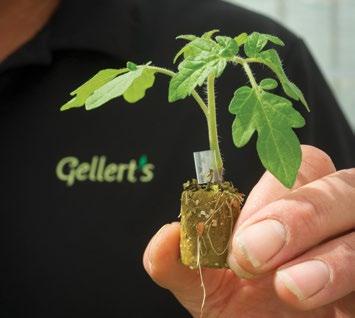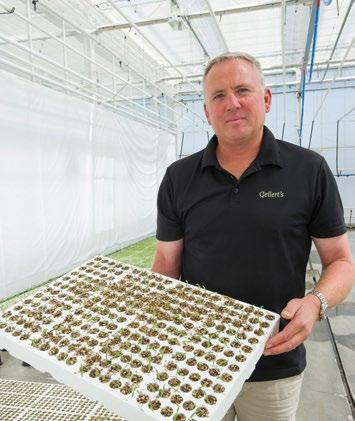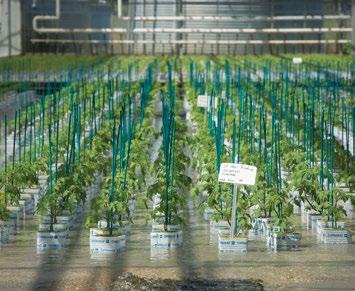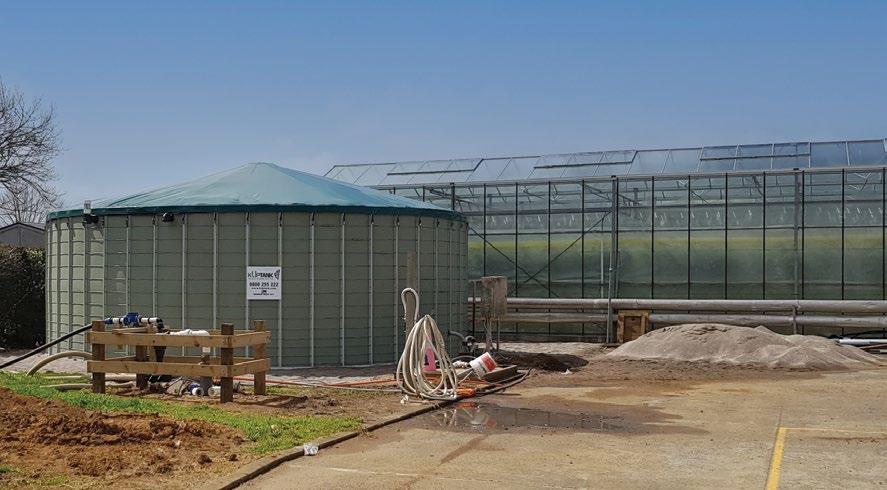
6 minute read
Gellert Nurseries expands in challenging times
GELLERT NURSERIES EXPANDS
IN CHALLENGING TIMES
Geoff Lewis
Horticultural propagators are an essential first step in the highly productive glasshouse and covered growing industry and are impacted by labour, Covid-related import challenges and, critically for indoor horticulture, energy supplies.
Gellert Nurseries at Karaka was established in 1988 on 6ha of what was the family dairy farm in the ’dark days’ of growing in soil. Director Steve Gellert and wife Gillian bought the operation from his parents. At one time out in the country, it now faces burgeoning urban development just over the fence. Gellert Nurseries is one of the two largest growers of seedling plants in the New Zealand horticultural industry. A little over half the business is providing millions of tomato, capsicum, aubergine and, until recently, cucumber seedlings in dozens of varieties, to other glasshouses and covered growing operations nationwide. Included in the output are new varieties of kiwifruit in contract trials for Zespri and Plant and Food Research. Gellert Nurseries is also a massive supplier of popular indoor pot plants and orchids, all for the domestic market. The covered crop vegetable industry underwent massive growth in the 1990s but has been pretty static since, Steve says. But what has gone ahead in a big way has been interest in leafy greens, strawberries, blueberries and protected kiwifruit. The site currently has 3.2ha under glass and is almost full. Steve has one new 8200 sqm glasshouse to go, with builders planned on-site in March. Around $3 million worth, it is currently lying on site wrapped in its import packaging.
Photography; Trefor Ward
“I have a whole brand-new greenhouse in bits. Our current glasshouses are manually operated systems, but the new glasshouse will be computer-controlled and fully automated with 900 x 4.5/2m (seedling) tables moved by two robots. All the grower must know is how to input information.“ This will reclaim space for Gellert’s vegetables operation, which is all on precision-built concrete ’ebb and flood’ floors. Cucumber production has been hit by a disease, which is thought to be an agrobacterium which creates ’beaded roots’ and stunts the growth of the plant. “No one has been able to figure out what it is so far. It was a tough decision to go out of cucumbers. We announced it to the industry last year and we’re still trying to find a solution.
In propagation, the aim is to provide a consistent highquality product at a competitive price, on time, all year. There are two major players nationally, Gellert and Zealandia, and it is a very competitive industry, Steve says. At Karaka, the seedling plants are grown in a rockwool substrate which acts as a medium and conduit for water and nutrients. Gellert is an agent for the Cultilene brand of substrate. But the trade has been impacted by Covid-19 delays. “We would normally bring in 120 containers (of substrate) from Europe. Growers use slabs in greenhouses. But due to shipping disruptions, importation has turned to custard.”

Steve Gellert, director
”What used to take six weeks from Holland, can take six months with the product stuck in Malaysia or Singapore for months. The cost of rockwool slabs has gone up by about 1.5 times. Forty-foot containers that used to be $5000 to $6000 are now about $16,000.” Essential convergent factors in undercover growing include labour, light, heat and CO2. As Steve explains, by Northern Hemisphere standards, New Zealand has very harsh light with high ultraviolet (UV) levels. “There are limiting factors. In summertime it’s the amount of light we get and the severity of the sunlight. We have screens and we put chalk coatings on the greenhouse, one in September and the second before Christmas as light protection. We remove it before winter.“ Once built, Gellert’s new glasshouse will use ’diffuse glass’ which spreads the light in all directions, and a double antireflective coating which pulls light in. Along with natural light, the nursery uses HPS (high pressure sodium) lamps and is considering LED (light-emitting diode) lighting going forward to help reduce power demand and as the science behind the use of LED lighting develops. “We use grow-lights to guarantee quality of production for the customer, but HPS lights require big infrastructure in transformers, cables, switchboards along with the fittings and lamps. “I can see in the next five years it will become economical to move to LED lighting. The technology is getting smarter.

In the nursery
The knowledge around the use of the light spectrum is also developing which will allow the creation of specific light recipes for different plants.“ Grow-lights are used in two ways – to guarantee a minimum light level on overcast days, and to give a certain number of hours of light as daylight hours get shorter during the winter months. “We have PAR (photosynthetically active radiation) sensors fitted around the nursery, so we know what light we have. Light is essential to plants. There is a lot of research going on around the levels of light you need with different crops, different shades of light, white, red, blue, it’s a recipe, the technology is getting better all the time.“ When it comes to greenhouse heating, Gellert uses natural gas which has become subject to market supply and price challenges. “The price of gas is insane. For years we took it for granted. My gas contract is due to run out in February 2023. About 18 months ago I went to the market and asked for prices. There are four major gas suppliers. All declined to supply. In the end one company came back to me and agreed to supply at a 50 percent cost increase. The two biggest growers in New Zealand are purchasing gas month by month at this moment.“
Gellert’s Karaka site has 35 growing ’compartments’ under glass which range in temperature between 15 degrees and 28 degrees depending on the requirement of the plants.
“We must have heat. In its first term the government decided to stop future offshore (oil and gas) exploration and the development of new supply. There was no consultation with industry. They took away our gas supply overnight with nothing to replace it. Now we’re importing coal from Indonesia. You can’t just turn the tap off if you have no alternative.“ For irrigation and other water needs, Gellert collects rainwater from 3.2 ha of roof area and has 11 million litres of water storage capacity. This provides between 90 and 95 percent of annual water requirements. Bores can also be brought into use in particularly dry summers. “We recycle 100 percent of what we use, except what is used to back-wash our filter system. Our water is UV sterilised and we are about to install a couple of ultra-filtration units.“ The nursery business employs about 50 people year-round and hasn’t had the major labour problems faced by businesses with more seasonal requirements. “Most large horticultural companies are advertising for labour. One of our biggest customers has delayed planting by six weeks, and another has taken 2.5ha of greenhouse out of production because they can’t find labour. “Our strategy is to bring specialist staff into the business. Now we are trying to find a head grower for our vegetable production.

Thriving seedlings
”What we do in propagation is done all around the world, so we’re looking for a person who can own the position. We got one specialist in from Australia during the last Covid-19 (travel) bubble. We don’t need general labour. We need people who can understand the science and plant physiology. People who want to make a career out of growing.“













